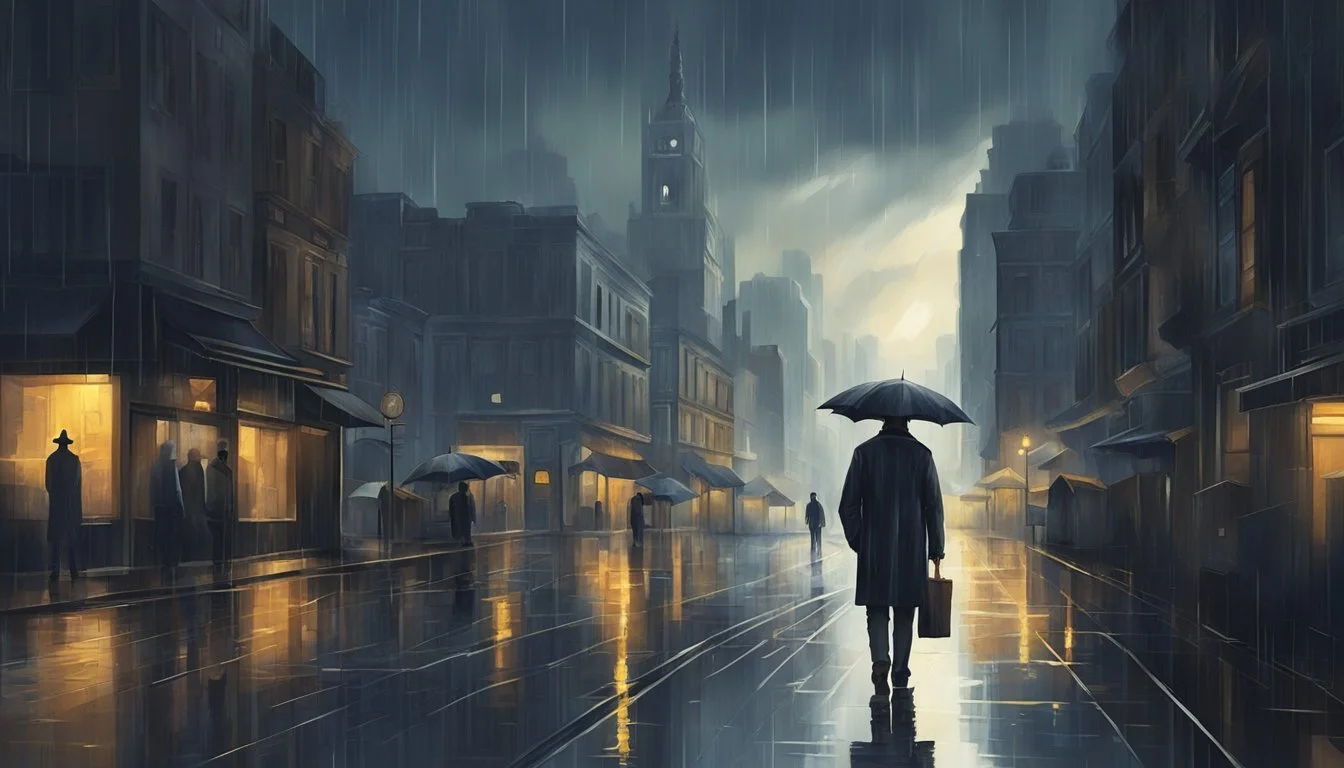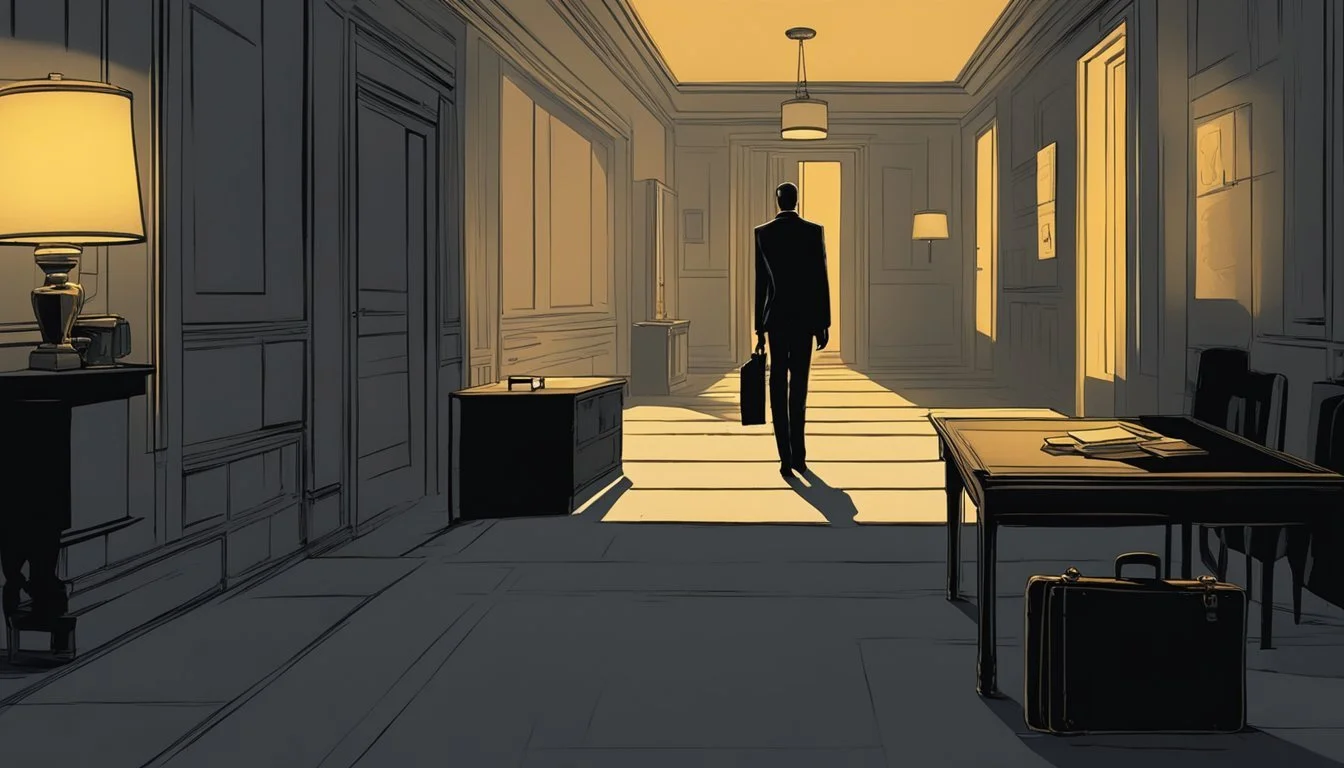Analyzing the Opening Sequence of "The Night Agent": Crafting Tension and Intrigue
"The Night Agent" captivates viewers from its very first moments. The opening sequence of this Netflix action thriller sets the stage for a gripping tale of conspiracy and danger. FBI agent Peter Sutherland finds himself thrust into a high-stakes world of political intrigue and covert operations.
The show's opening sequence expertly blends tension, mystery, and action to hook viewers immediately. It introduces Peter as a low-level FBI agent working the night shift at the White House, foreshadowing the complex web of deception he'll soon uncover. This initial setup efficiently establishes the series' tone and premise.
As "The Night Agent" progresses into its second season, the opening continues to evolve. The show expands its scope, taking Peter's missions global. Season 2's opening reportedly features an intense chase sequence through the streets of Bangkok, showcasing the series' commitment to thrilling action set pieces and international intrigue.
Series Overview
"The Night Agent" is a gripping action-thriller series that blends espionage, conspiracy, and high-stakes political intrigue. The show follows a low-level FBI agent who becomes entangled in a complex web of secrets and danger.
Concept and Genre
"The Night Agent" centers around Peter Sutherland, an FBI agent assigned to the Night Action Program. His role involves monitoring an emergency line that never rings - until one fateful night. The series combines elements of action, thriller, and spy genres.
Peter finds himself thrust into a dangerous conspiracy reaching the highest levels of government. The show explores themes of loyalty, trust, and the blurred lines between allies and enemies.
Development and Production
Shawn Ryan, known for "The Shield," adapted "The Night Agent" from Matthew Quirk's novel. Netflix greenlit the series, aiming to create a binge-worthy thriller for its platform.
The production team focused on crafting authentic action sequences and intricate plot twists. They aimed to balance character development with fast-paced storytelling.
Filming took place in various locations to capture the diverse settings of Washington D.C. and beyond. The creators emphasized visual storytelling to complement the tension-filled narrative.
Critical Analysis of Opening Sequence
The opening sequence of "The Night Agent" sets the stage for a gripping political thriller. It efficiently introduces key characters, establishes the series' tone, and hints at the high-stakes conspiracy to come.
Establishing Shots and Setting
The sequence begins with sweeping aerial shots of Washington D.C. at night. Iconic landmarks like the Capitol and Washington Monument are prominently featured, immediately placing the story at the heart of American political power.
The camera then shifts to ground level, showcasing the bustling streets and government buildings. This juxtaposition of grand architecture and street-level activity effectively conveys the dual nature of the city - both a symbol of democracy and a place where ordinary people live and work.
A quick cut to an opulent restaurant in Bangkok provides a stark contrast, hinting at the global scope of the unfolding plot.
Character Introductions
Peter Sutherland, the protagonist, is introduced at his post in a dimly lit office. His alert posture and focused gaze convey dedication, while his relatively sparse surroundings suggest his low-level status within the FBI.
Rose Larkin is shown in a more dynamic setting, navigating the streets of D.C. with purpose. Her casual yet professional attire and confident stride establish her as a capable character separate from official government channels.
Brief glimpses of President Travers and Vice President Redfield in formal settings efficiently establish the highest levels of power involved in the story.
Tone and Atmosphere
The sequence employs a muted color palette dominated by blues and grays, creating a sense of tension and unease. Sharp cuts between locations maintain a brisk pace, mirroring the urgency of the plot.
Low-angle shots of government buildings loom ominously, suggesting hidden threats within seemingly secure institutions. The constant background hum of activity - ringing phones, hurried footsteps, distant sirens - builds an atmosphere of barely contained chaos.
The emergency phone line Peter monitors serves as a focal point, its silent presence a constant reminder of potential danger. This visual motif effectively foreshadows the conspiracy and treason that will drive the series' plot.
Character Analysis
The opening sequence of "The Night Agent" introduces key players and sets up intriguing character dynamics. Peter Sutherland emerges as a complex protagonist, while supporting characters and antagonists add depth to the unfolding narrative.
Protagonists' Arcs
Peter Sutherland, a young FBI agent, takes center stage as the main protagonist. His assignment to the White House night shift catapults him into a world of high-stakes espionage. Peter's character arc is shaped by his determination to uncover the truth and redeem his family name.
Rose Larkin, a tech CEO caught in the crossfire, becomes Peter's unlikely ally. Her quick thinking and resourcefulness complement Peter's skills, forming a dynamic duo. Their growing trust and chemistry add an emotional layer to the plot.
Supporting Characters
Amanda Warren, Peter's supervisor, plays a crucial role in guiding him through the maze of political intrigue. Her no-nonsense attitude and experience provide valuable support to Peter's mission.
Chelsea Arrington, a Secret Service agent, adds another dimension to the story. Her professional demeanor and dedication to duty create interesting interactions with Peter and other characters.
Diane Farr, as National Security Advisor, brings gravitas to the political aspects of the plot. Her presence heightens the stakes and adds complexity to the unfolding conspiracy.
Antagonists and Conflict
The opening sequence hints at a shadowy organization called Foxglove, setting up the main conflict. This mysterious group is linked to various nefarious activities, including the Metro bombing and assassination attempts.
Jacob Monroe emerges as a potential double agent, adding layers of suspicion and intrigue. His ambiguous loyalties create tension and keep viewers guessing about his true motives.
The concept of trust becomes a central theme, with characters constantly questioning who they can rely on. This atmosphere of suspicion adds depth to character interactions and drives the plot forward.
Narrative Structure
The opening sequence of "The Night Agent" establishes key narrative elements that drive the story forward. It introduces central characters, sets up conflicts, and lays the groundwork for the overarching conspiracy plot.
Plot Progression
The sequence begins with FBI agent Peter Sutherland on duty in the White House basement. A mysterious phone call disrupts his routine, thrusting him into a dangerous conspiracy. This inciting incident propels the plot, setting up the central conflict.
Peter's encounter with Rose Larkin, a civilian seeking protection, adds complexity to the storyline. Their alliance forms the core of the narrative, as they navigate treachery and uncover a far-reaching plot against the government.
The rapid-fire introduction of characters and plot points creates momentum. It hints at connections between seemingly unrelated events, inviting viewers to piece together the puzzle.
Suspense and Pacing
Quick cuts and tense music build suspense from the start. The pacing alternates between moments of quiet tension and bursts of action, keeping viewers on edge.
The sequence employs cliffhangers effectively. Abrupt scene changes and unresolved questions compel audiences to keep watching. Each revelation raises new questions, maintaining a sense of urgency.
Time-sensitive plot elements, like potential attacks or deadlines, add pressure. This creates a ticking clock effect that drives the narrative forward and heightens stakes for the characters.
Themes and Motifs
Trust emerges as a central theme in the opening. Peter's role as a night agent requires faith in the system, yet the unfolding events challenge this trust. The sequence introduces the idea that appearances can be deceiving.
Counterintelligence and the blurred lines between allies and enemies feature prominently. Visual motifs like surveillance cameras and computer screens reinforce themes of secrecy and hidden agendas.
The contrast between the White House setting and the dark conspiracy hints at corruption within trusted institutions. This sets up an exploration of power dynamics and the potential for treason at the highest levels of government.
Visuals and Cinematography
The opening sequence of "The Night Agent" employs striking visual techniques and cinematography to establish the tone and atmosphere of the series. The camera work and lighting choices work in tandem to create a sense of tension and intrigue.
Camera Work
Dynamic camera movements enhance the action scenes in the opening sequence. Quick pans and tracking shots follow the characters as they navigate tense situations. Close-ups on faces capture subtle expressions, revealing hidden motives and emotions.
The camera often adopts a low angle during confrontations, making characters appear more imposing. This technique heightens the sense of danger and power dynamics at play.
Steady wide shots are used to establish key locations like the extraction point. These help orient viewers in the space and build anticipation for upcoming events.
Lighting and Color Palette
The lighting design in the opening sequence creates a moody atmosphere. Low-key lighting with strong shadows emphasizes the clandestine nature of the characters' activities.
Cool blue tones dominate nighttime scenes, evoking a sense of mystery and danger. Warm amber lighting is used sparingly for interior locations, providing contrast and visual interest.
Harsh, high-contrast lighting is employed during intense moments, casting dramatic shadows across faces and environments. This technique amplifies the tension and suspense.
The color palette shifts subtly throughout the sequence. It begins with muted, desaturated tones and gradually introduces more vibrant colors as the action intensifies.
Soundtrack and Score
The soundtrack and score of "The Night Agent" play a crucial role in establishing the show's atmosphere and enhancing its storytelling. The carefully crafted audio elements work in tandem to create tension, evoke emotion, and underscore key moments.
Music Themes
The opening sequence of "The Night Agent" features a compelling musical theme that sets the tone for the series. A pulsing electronic beat underpins suspenseful string arrangements, immediately signaling the show's blend of modern espionage and classic thriller elements. This theme recurs throughout the series, often with subtle variations to match different moods and plot developments.
For action scenes, the score intensifies with rapid percussion and driving rhythms. These musical cues heighten the sense of urgency and danger, particularly during chase sequences or confrontations. In contrast, quieter, more introspective pieces accompany character-driven moments, using piano or solo instruments to convey vulnerability or contemplation.
Sound Design
The sound design in "The Night Agent" is meticulous, creating a rich auditory landscape that immerses viewers in the world of high-stakes espionage. Ambient sounds of bustling city streets, quiet offices, and secure facilities are carefully layered to establish each setting.
During tense scenes, subtle audio effects like muffled heartbeats or the ticking of a clock ramp up anxiety. The show makes effective use of silence as well, with sudden drops in background noise heightening dramatic moments. Tech-related scenes featuring the fictional CEO character are often accompanied by the soft hum of computers and electronic beeps, reinforcing the high-tech nature of modern intelligence work.
Reception and Impact
"The Night Agent" opening sequence garnered attention for its stylish visuals and tension-building elements. Critics and viewers alike responded to its effectiveness in setting the tone for the series.
Critical Reception
The opening sequence of "The Night Agent" received praise from critics for its slick production values and atmospheric tone. Many reviewers highlighted how it effectively established the show's espionage themes. The use of shadowy imagery and quick cuts drew comparisons to classic spy thrillers.
Some critics noted the sequence's ability to convey complex plot elements efficiently. The visual storytelling was commended for introducing key characters without dialogue. A few reviewers felt the opening was slightly derivative of other spy series but still found it compelling.
Audience Response
Viewers responded positively to "The Night Agent" opening, with many praising its ability to hook them from the start. Social media buzz centered on the sequence's moody aesthetics and pulse-pounding score. Fans frequently cited it as a standout element of the show.
The opening's popularity contributed to increased anticipation for Season 2. Some viewers created fan edits and tributes based on the sequence, sharing them online. A few audience members noted that repeated viewings revealed subtle details they initially missed.
Amanda Warren's brief appearance in the opening garnered particular interest from fans. Her role as the President's Chief of Staff became a topic of speculation among viewers. The sequence's success likely influenced promotional strategies for future seasons.
Future Prospects
"The Night Agent" has set the stage for an exciting future. Upcoming seasons and potential spin-offs promise to expand the thrilling world of espionage and political intrigue.
Season 3 Expectations
Season 3 of "The Night Agent" is poised to deliver high-octane action from the start. The showrunners have teased a "spectacular" opening sequence, hinting at even more ambitious stunts and plot twists. Fans can anticipate a deeper dive into the ongoing conspiracy, with the mysterious Jacob Monroe likely playing a pivotal role.
The global scale of operations may increase, building on the Bangkok setting from Season 2. This expansion could see Peter Sutherland facing new challenges in exotic locations worldwide.
A potential cliffhanger from Season 2 might set up a critical mission at Camp David, raising the stakes for national security.
Potential Spin-offs
Netflix's success with "The Night Agent" opens doors for spin-off possibilities. A prequel series could explore the origins of key characters or delve into historical espionage cases that shaped the current storyline.
A spin-off focusing on secondary characters from the main series might gain traction. This could follow agents in different departments or locations, expanding the show's universe.
An anthology series set in the same world is another option. Each season could tackle a different conspiracy or threat, linking back to the main series' events.







